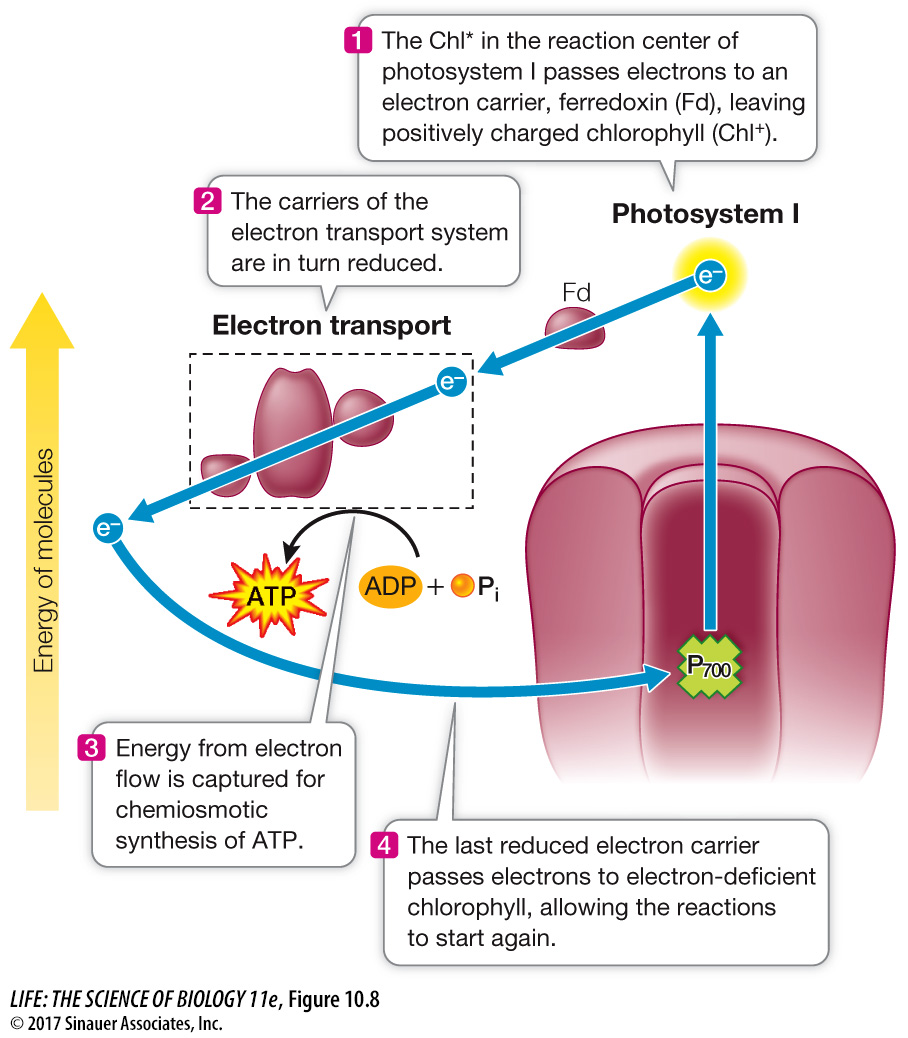Reduction leads to ATP and NADPH formation
The electron acceptor that is reduced by Chl* is the first in a chain of electron carriers in the thylakoid membrane. Electrons are passed from one carrier to another in an energetically “downhill” series of reductions and oxidations. The final electron acceptor is NADP+, which gets reduced:
NADP+ + H+ + 2 e–→NADPH (10.7)
As in mitochondria, ATP is produced chemiosmotically in the thylakoid membrane during the process of photophosphorylation, which we will illustrate shortly. The overall process involves two *electron transport processes, noncylic and cylic. The noncyclic electron transport reactions that use the energy from light to generate ATP and NADPH are illustrated in Figure 10.7.
*connect the concepts The thylakoid membrane has an electron transport system similar to the respiratory chain of mitochondria (see Key Concept 9.3).
As seen in Figure 10.7, two coordinated photosystems, each with its own reaction center, collaborate to produce ATP and NADPH:
Photosystem I (containing the “P700” chlorophylls at its reaction center) absorbs light energy best at 700 nm and passes its excited electrons (via intermediate molecules) to NADP+, reducing it to NADPH.
Photosystem II (with “P680” chlorophylls at its reaction center) absorbs light energy best at 680 nm, oxidizes water molecules, and passes its energized electrons through a series of carriers to produce ATP.
Let’s look in more detail at these photosystems, beginning with photosystem II.
PHOTOSYSTEM II After an excited chlorophyll in the reaction center (Chl*) gives up its energetic electron to reduce a chemical acceptor molecule, the chlorophyll lacks an electron and is very unstable. It has a strong tendency to obtain an electron from another molecule to replace the one it lost—
H2O → ½ O2 + 2 H+ + 2 e– (10.8)
2 e– + 2 Chl+ → 2 Chl (10.9)
Overall: 2 Chl+ + H2O → 2 Chl + 2 H+ + ½ O2 (10.10)
Notice that the source of O2 in photosynthesis is H2O (as demonstrated in Investigating Life: What Is the Chemistry of Photosynthesis, and How Will Increasing CO2 in the Atmosphere Affect It?).
Back to the electron acceptor in the electron transport system: the energetic electrons are passed through a series of membrane-
PHOTOSYSTEM I In photosystem I, an excited electron from the Chl* at the reaction center reduces an acceptor. The oxidized chlorophyll (Chl+) now obtains an electron, but in this case the electron comes from the last carrier in the electron transport system. This links the two photosystems chemically. They are also linked spatially, with the two photosystems adjacent to one another in the thylakoid membrane. The energetic electrons from photosystem I pass through several molecules and end up reducing NADP+ to NADPH.
Next in the process of harvesting light energy to produce carbohydrates is the series of carbon-
